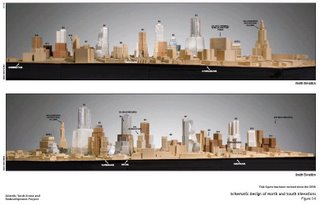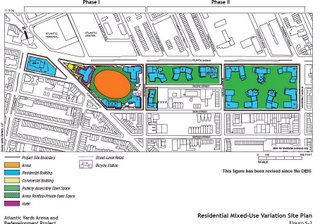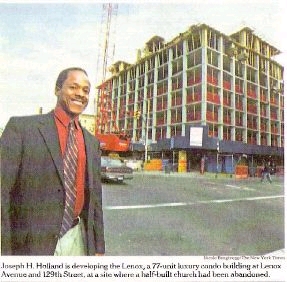 Yes, it was rubberstamped. Even though Empire State Development Corporation (ESDC) Chairman Charles Gargano had said in a radio interview Thursday that “it’ll be up to the board members to vote yes or no” on the Atlantic Yards project, the press release had already been prepared when the 3:30 pm board meeting began yesterday.
Yes, it was rubberstamped. Even though Empire State Development Corporation (ESDC) Chairman Charles Gargano had said in a radio interview Thursday that “it’ll be up to the board members to vote yes or no” on the Atlantic Yards project, the press release had already been prepared when the 3:30 pm board meeting began yesterday.That press release indicated that the board had approved the plan for the project, the Final Environmental Impact Statement (FEIS), the override of city laws governing such things as zoning and signage, and the power to use eminent domain.
So the special board meeting, which lasted about 15 minutes and attracted a cluster of television cameras, was a mere formality. Only four of the agency’s seven board members, including Gargano, were present, but that meant a quorum.
Their brief questions and comments showed neither much understanding of the project location nor sympathies toward public concerns. And Gargano, gamely taking some tough questions from reporters afterward, gave no quarter.
The agency received nine letters since the Final Environmental Impact Statement (FEIS) was issued November 27 but none caused the agency to change course. Develop Don’t Destroy Brooklyn (DDDB) argued that the FEIS was "fatally flawed" because of, in part, miscalculation of open space; failure to address emergency response times; and a failure to respond to criticisms of the ESDC's blight study.
The Council of Brooklyn Neighborhoods (CBN) also deemed the FEIS inadequate, citing, among other things, "self-referential circular logic" in the responses and a failure to consider terrorism among worst-case scenarios.
More call for PACB delay
Now the project goes to the Public Authorities Control Board (PACB), which is scheduled to meet December 20. The three controlling voters are Gov. George Pataki, Senate Majority Leader Joseph Bruno, and Assembly Speaker Sheldon Silver, the only Democrat. There’s been considerable pressure on Silver, who supports the project, to delay it until the administration of incoming Governor Eliot Spitzer, a fellow Democrat.
Yesterday, Hakeem Jeffries, Assemblymember-elect for the 57th District, which includes the Atlantic Yards site, urged the PACB to delay the vote until the affordable housing program is modified, the project size is reduced, and the eminent-domain case is resolved. He joins a trio of Assemblymembers who have also asked for the project to be delayed and modified.
Also, several community, environmental, and good government groups, including the Sierra Club, the Natural Resources Defense Council, and Good Jobs New York, called on the PACB to postpone their vote to allow for more time to evaluate flaws in the review of environmental impacts and to gain “full, transparent disclosure of the project's public financing and the developer's profit.” The groups will hold a press conference at City Hall on Monday at 1:30 p.m.
Boilerplate process
 The meeting, held in the 37th floor boardroom at ESDC headquarters at 633 Third Avenue, began as Ann Hulka, a senior VP for real estate, uninflectedly read a boilerplate description of project changes officially announced last month, including plans for a school.
The meeting, held in the 37th floor boardroom at ESDC headquarters at 633 Third Avenue, began as Ann Hulka, a senior VP for real estate, uninflectedly read a boilerplate description of project changes officially announced last month, including plans for a school.There was one intriguing change: Atlantic Yards, following a recent 8% trim, is now described as a $4 billion project, not a $4.2 billion one.
“The entire project is expected to be completed by 2016,” she recited dutifully, adding that the project “avoids or minimizes adverse environmental impacts to the maximum extent practicable… and provides mitigation where practical and feasible.”
“A blight study was prepared which documents blighted conditions on the project site. ESDC intends to exercise the power of eminent domain to remove these blighted conditions," Hulka continued. "Various objections were raised and outlined in the materials. Without condemnation, ESDC would be unable to assemble the site, remove the blighted conditions on the site, and develop the project.”
She noted the pending eminent domain case: “The corporation is vigorously defending the litigation and expects to prevail.”
Demonstration time
Then ESDC Director of Planning and Environmental Review Rachel Shatz described the project as presented on large posterboards, adding that the project had been reduced by 8 percent “in response to comments we received from the public and specific recommendations” from City Planning Commission.
 |
| Dorkey |
Post-FEIS letter
“There were letters submitted to the corporation on the Final Environmental Impact Statement following its issuance on November 27,” Shatz reported. “We received a total of nine letters, as of today. Staff with our consultants carefully considered all the comments and determined that no new issues had been raised, and there is no need for any additional analysis in light of the information and conclusions in the FEIS, and the directors have all received copies of these letters.”
(I asked for copies of the letters and the responses, and was told they'd be provided shortly.)
Board member Joseph Holland asked a basic question: “Is there any allowance for flexibility in the project program once the GPP is affirmed?”
Shatz responded that the FEIS had analyzed the residential variation, three of the four buildings around the arena devoted to housing, but there’s an alternate option that uses commercial space instead. (The “worst case” impacts would come from the residential version, so that’s why it was studied in the FEIS.)
Looking at the map
A little later, Dorkey had identified Atlantic and Flatbush avenues on one posterboard. He pointed to the southern border of the project site. “Is that Pacific, at the bottom of the project?”
“This is Dean Street,” Shatz responded, offering some basic Brooklyn map work. “Pacific is the one in the middle.”
Timeline
 Holland (right) asked about the timeline for the project, seemingly an issue already covered.
Holland (right) asked about the timeline for the project, seemingly an issue already covered.“The way that we’re looking at it now,”Hulka responded, “the first phase, assuming no litigation, the first phase of the project—
“Assuming no delays from litigation,” Gargano interjected, leaning forward a little tensely.
Hulka reiterated that the first phase—five towers, an arena, and a new and relocated railyard—would be completed by 2010, with the remainder of the project completed by 2016.
Security issue
Then board member Kevin S. Corbett, a former agency executive, raised the issue of security, piquing the interest of several people in the room representing DDDB and the Council of Brooklyn Neighborhoods. But what he said didn’t respond to their concerns about the agency’s failure to consider post-9/11 terrorism.
 |
| Corbett |
Corbett said the plan responds to the post-9/11 environment and smart growth around transportation. He pointed out that the Regional Plan Association (RPA) has opposed some projects but has favored this one. (Not completely.) “This project seems like a great project,” he concluded.
Eminent domain
Dorkey asked general counsel Anita Laremont if ESDC was satisfied with the blight study needed to pursue eminent domain.
“We’re very confident,” Laremont said.
The board then voted 4-0 to approve the various elements of the project, and dispersed. Absent were members David H. Feinberg, Mark Hamister, and Diana Taylor.
What the RPA said
I caught up with Corbett in the hall, identified myself as a journalist and said I had a few questions. He told me that the press should speak to the ESDC press officer.
I pressed on, saying that he’d brought up the RPA statement in favor of the project (He’s an RPA board member.) I pointed out that the RPA’s statement was very critical of the second half of the project.
He responded, “From the meeting I was in with the RPA and again, you’d have to go to [RPA President] Bob Yaro for that, but those issues were addressed.”
There’s no evidence that the RPA’s call for turning the open space into city parkland and a design review process a la Battery Park City has been heeded.
Gargano under the gun
 |
| Gargano |
Nicholas Confessore of the New York Times was first out of the box, pointing out to Gargano (right) that he'd made factually incorrect and contradictory statements.
“I have no idea of what you’re talking about,” Gargano responded testily. “If you’re going to ask me a question, ask me a question,”
Confessore continued, and Gargano responded, “Eminent domain has not occurred on this project. I never said it did.”
Confessore returned a bit later with the direct quote from Gargano’s May 17 interview in Metro, which was cited in the lawsuit filed yesterday: “The facts are that we didn’t really have to use eminent domain because there were friendly condemnations done. The amount of condemnation that we had to do was very small.”
“I don’t know what’s written there,” Gargano said. “What I probably did say, I recall, is that if there is any condemnation that will be required, it would be very small.”
[The Times's coverage was the most thorough in the dailies, mentioning the new lawsuit. The Daily News was brief. The Post focused on the politics. The Associated Press, in a story that appeared in hundreds of outlets around the country, relied significantly on the press release.]
Buildout delay?
I pointed out the skepticism of the planned ten-year buildout expressed by Kathryn Wylde of the Partnership for New York City, who suggested the project would likely take 15-20 years. “So how can you say this environmental review is sufficient?” I asked.
“Number one, I don’t know where Ms. Wylde’s facts come from” he responded. “We hire consultants to advise us on these issues. Turner Construction is a very well-known developer who has decades and decades of experience… This project will be built in quarters, in sections, and they have broken it down for us. And they say the project can be built over a ten-year period. We depend on experts in this area to advise us. There are other people who can make comments all they want. I don’t know how valuable those comments are. If the project is estimated to take ten years and we have some delays, as a result of lawsuits or whatever, it could take 11 years, or 12 years. So what. But we have an estimate, assuming we have no unnecessary delays, of ten years, given to us, by expert developers. Those who are in the business of developing, those who understand construction, they’re the people we listen to, not the people who want to be out there talking numbers they have no knowledge of.”
(Actually, Turner Construction is working on the project for Forest City Ratner, as well)
“What about the track record with MetroTech?” I asked, pointing to Forest City Ratner's largest completed Brooklyn project. “MetroTech took nine years longer” than planned.
“I have very little knowledge about MetroTech,” he responded. “MetroTech started a long, long time ago.”
Security, round one
Have changes in the project been made in response to security concerns, he was asked.
“It’s an ongoing process,” Gargano replied, “and we have certainly during that process taken into consideration many security issues that we make public. Then there are other security issues where the sponsor of the project, the developer, is working with the appropriate agencies such as the New York City Police Department, on other security matters that are not for the public at this time.”
Has NYPD signed off on this one?
“NYPD has been consulted during the process of the FEIS, and it’s an ongoing thing with the developers and the New York City Police Department,” he responded.
Security, round two
I brought up the issue whether a large-scale terrorist attack is a "reasonable worst-case scenario," something the ESDC rejected, as DDDB had pointed out. "What do you say to the people of Brooklyn: is it an unreasonable worst-case scenario?"
“I’m not here to predict terrorist attacks," Gargano responded. "That’s for the security people to decide, and to take all the necessary precautions.”
I pointed to the EIS process.
“As I said the last time you asked me similar questions, the EIS is not really the place for--to find or resolve all of the security problems," he said. "As many as we possibly can anticipate, but it’s something we use experts for that. And that’s the New York City Police Department, and others, the sponsors, the developer, has ongoing discussions with them now about security for the project.”
Afterward, in an impromptu press conference outside the ESDC office at 633 Third Avenue, DDDB’s Daniel Goldstein called the agency’s posture “confounding. They’re building a glass tower… at a major transportation hub.”
CBA inclusion
The press release included comments from Governor George Pataki, Mayor Mike Bloomberg, Brooklyn Borough President Marty Markowitz, Gargano, and Deputy Mayor for Economic Development Dan Doctoroff.
There were no quotes from Forest City Ratner—though p.r. staff were at the meeting—and two quotes from people outside government. Praise came from Mike Fishman, president of 32BJ, Service Employees International Union, whose members would work in building maintenance.
And then there was a quote from Delia Hunley-Adossa, Community Benefits Agreement (CBA) Executive Committee Chair, who has been otherwise inaccessible to the press:
“Today is an important day for all of us,” said Delia Hunley-Adossa, Community Benefits Agreement (CBA) Executive Committee Chair. “This is a significant step forward for Atlantic Yards and for the Borough of Brooklyn. The project is more than an arena for the Nets; it is about affordable housing, it is about creating jobs for the community and it is about creating real business opportunities for communities that have been historically shut out of the process.’
Interestingly, there are a host of comments, pro and con, regarding the CBA, in the FEIS. Critics pointed out that it’s unenforceable because it’s not written into the plan itself. The ESDC responded briefly, suggesting more of an arms-length posture than was demonstrated in the press release issued yesterday:
The CBA is an agreement between the project sponsors and certain community-based organizations and is separate from the GPP. The DEIS included elements of the CBA to the extent that they relate to the program elements that are part of the GPP.
It seems to me the law suits with respect to eminent domain will tell the tale. This project was not planned by a government entity and the entire development benefits one developer - Ratner. These two crucial points laid down in the recent Supreme Court decision will be used to argue against the use of eminent domain. A positive outcome will stop this project in its tracks. Development must be scaled down. Given the fact that the Atlantic Terminal Area has been in planning since the 1950's, another few years won't matter. Meanwhile a slow down in marketing all the other new buildings under construction (how goes 1 Hanson Place?) may have the greatest impact of all. Many of the "Yards" buildings are in significantly inferior locaitons. Neither Ratner nor the banks financing this project will proceed to build empty buildings. Time will tell.
ReplyDelete